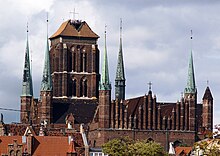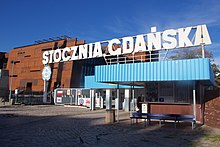Gdańsk - the city of memory and freedom

Gdańsk - City of Remembrance and Freedom is currently a World Heritage candidate in Poland . In the city of Danzig ( Gdańsk in Polish ), the candidacy covers parts and structures of the right city , the site of the former Danzig shipyard and the Westerplatte peninsula . The application is on the UNESCO tentative list under number 530 .
history
Second World War
With the attack on Poland and the bombardment of the Westerplatte in the Free City of Danzig , the Second World War began on September 1, 1939 . The world war ended in Europe after Karlshorst's declaration of surrender in the area of the former Free City. On May 9, 1945, the area between the Vistula and Vogelsang (Skowronki) on the Fresh Spit was handed over to the Red Army . When the Stutthof concentration camp was liberated , it found an almost completely evacuated camp.
From the world war to the turning point in Poland
The end of the world war meant flight and expulsion for the majority of the German population in Danzig. Gdansk became part of the Eastern Bloc with the Republic of Poland (since 1952 People's Republic ) . For the Poles, some of whom were forcibly relocated, a phase of lack of freedom and oppression began, against which resistance was particularly formed at the Danzig shipyards . During the December 1970 uprising, 45 people were killed in Gdansk and other cities on the Baltic coast.
The August strikes of 1980 , which led to the approval of free trade unions and Solidarność , were in the tradition of the events of 1970. The erection of a memorial to the victims of the December uprising was one of the 21 demands of the 1980 strikes . Two weeks before signing In response to government demands, a first wooden cross was erected in front of the main gate of the shipyard. The second signing of the August Agreement took place on August 31, 1980 in the industrial safety hall of the Danzig shipyard .
The movement of the free trade unions in Poland played a major role in the change in Poland in 1989/1990. On December 9, 1990, the union leader and former electrician of the Gdańsk shipyard Lech Wałęsa was freely elected President.
present
The Westerplatte , the building of the Polish Post Office and the memorial for the fallen shipyard workers are among the most important memorial sites in the city. In 2014 and 2017, the European Solidarność Center (Europejskie Centrum Solidarności, ECS) and the World War Museum (Muzeum II Wojny Światowej) were opened. The construction of a new historical museum is planned.
Scope of the application
Formalities
A first application was rejected by ICOMOS in 1998; a further attempt was initially withdrawn by the applicant in 2007. Applications are made for inclusion in the World Heritage according to criteria ii, iv and vi:
- Criterion ii: Gdansk is an example of the architecture, town planning and techniques of founding structures near the water at the turn of the 16th to the 17th century.
- Criterion iv: The buildings are excellent examples of building type and architecture at the turn from Gothic to Renaissance . The brick Gothic buildings are among the largest of their kind and testify to the techniques of the Gdańsk builders. The cityscape of the historic city is embedded in old fortifications and can be read from the Motława River and the surrounding hills.
- Criterion vi: The buildings of the city bear testimony to the high value of freedom for its citizens. - The memorial on the Westerplatte is of exceptional importance as the place where the Second World War broke out. It is also a symbol of defending the ideals of freedom in war. - The events around the Gdańsk shipyard were of central importance for the future of Europe and the world. The events showed non-violent methods of fighting oppression and dictatorship .

Rechtstadt (Główne Miasto)
The application covers an area of 0.97 hectares with the following structures:
- Crane gate
- Golden Gate
- High gate
- Torment Chamber and Stock Tower
- Green gate
- Right town hall
- Artus Court
- Fountain of Neptune
- Courtyard of the St. George Rifle Brotherhood
- Marienkirche with outbuildings
- Royal Chapel
- Uphagenhaus
Westerplatte
The application covers an area of 61.95 hectares .
Gdańsk shipyard
The application covers an area of 1.82 hectares .
- Gate 2 of the Gdańsk Shipyard (since 1967 also the Lenin Shipyard , Stocznia Gdańska im. Lenina)
- Industrial safety hall at the Gdansk shipyard
- Memorial to the fallen shipyard workers from 1970 (Pomnik Poległych Stoczniowców 1970)
See also
Web links
- whc.unesco.org: Gdansk - Town of Memory and Freedom. (English)
Individual evidence
- ↑ a b c d e f g h whc.unesco.org: Gdansk - Town of Memory and Freedom. (English, accessed June 12, 2020)
- ↑ Elżbieta Grot: Obóz Stutthof. In: Gedanopedia (Polish, accessed July 31, 2020)



